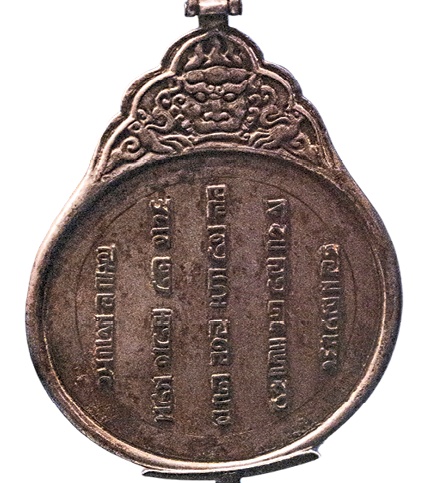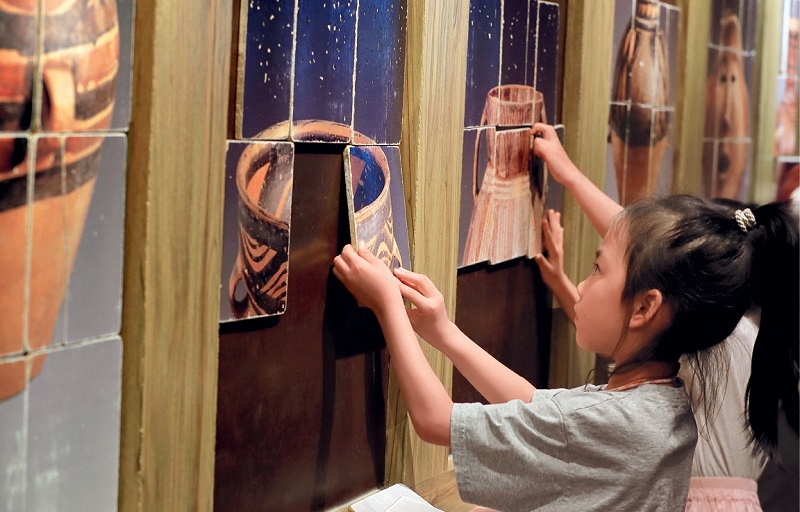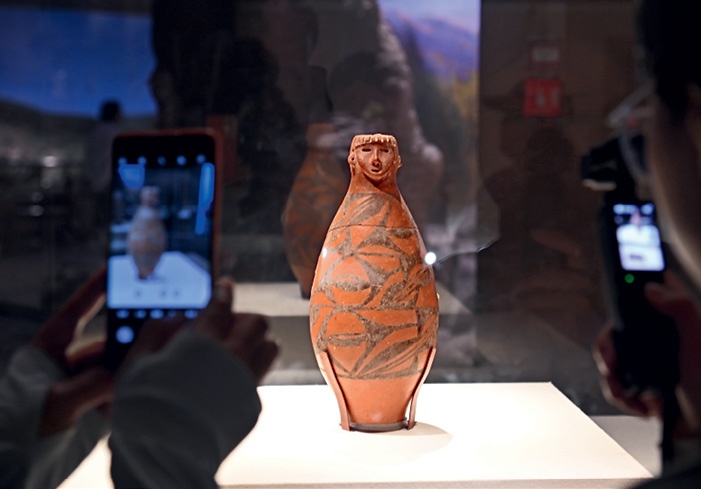Visiting the Gansu Provincial Museum is like time traveling down the halls of history – tracing the roots of the Chinese civilization and exploring the exchanges of cultures along the ancient Silk Road.

The Bronze Galloping Horse is one of the most iconic items at the Gansu Provincial Museum.
Gansu Province is located in the upper reaches of the Yellow River in northwest China and at the junction of the Loess Plateau, Qinghai-Xizang Plateau, and Inner Mongolian Plateau. Home to 55 ethnic minority groups, it’s a land where the ancient cultures of the Silk Road, Yellow River, and Great Wall, as well as Red Culture – a culture that has developed over the course of China’s revolution, construction, and reform under the leadership of the Communist Party of China (CPC) to achieve national independence, economic growth, cultural prosperity, and national rejuvenation – converge. Gansu is especially known for being the cradle of an over 1,600-kilometer-long “golden section” of the Ancient Silk Road, which made it a center of extensive exchanges between ancient civilizations.
The Gansu Provincial Museum located in Lanzhou, the provincial capital, covers a total exhibition area of 28,500 square meters, and is designed with 18 galleries and five permanent exhibitions. It enjoys a vast collection of over 80,000 historical relics and natural specimens (sets), including 16 national treasures. Among its star exhibits are the Bronze Galloping Horse, the Silver Round Tally with a tiger-shaped head and an inscription in Basiba script, the Gilded Silver Tray of the Eastern Roman Empire, and the Painted Pottery Vase with a Human-head Shaped Mouth.

The Yuan Dynasty Silver Round Tally designed with a tiger-shaped head and inscription in Basiba script can now be viewed at the Gansu Provincial Museum.
Bronze Galloping Horse
The Bronze Galloping Horse, dating back to the Han Dynasty (206 B.C.-220 A.D.), is one of Gansu’s most iconic cultural relics. It stands 34.5 centimeters tall, 45 centimeters long, and weighs 7.3 kilograms. The artifact depicts a muscular horse dashing forward in mid-flight, with three legs lifted in the air and one hoof lightly resting on a startled bird, exuding an air of dauntless determination. The bird is looking back to check what is happening while the horse is speeding by. In 1983, the Ministry of Culture and Tourism designated the Bronze Galloping Horse as the official symbol of Chinese tourism.
“Artifacts featuring horses were very common in the Han Dynasty, but this is the only one that depicts a horse standing on a bird to symbolize speed,” explained Ban Rui, director of the Gansu Provincial Museum. He noted that the entire weight of the galloping horse is supported by a single bird which serves as this piece’s center of gravity. Artisans ingeniously used the bird’s body and outstretched wings to enlarge the contact area. At the same time, iron cores were embedded inside the horse’s legs to enhance support and strength of the structure, ensuring that the Bronze Galloping Horse would stand firm for over a thousand years.
The horse is depicted moving its legs forward on the same side together. “This gait is similar to the lateral gait, a dressage movement in modern equestrianism, and is rarely seen in normal horse riding,” Ban explained. The item was excavated in 1969 from the Leitai Han Tomb in Wuwei, Gansu Province which is a part of the Hexi Corridor, a well-known section of the Ancient Silk Road. The lateral gait reflects the characteristics of horse riding in this region. On the uneven sandy roads, the horse gait helped ease the jolts for travelers riding along the Silk Road.

Children are piecing together a cultural relics-themed puzzle at the Gansu Provincial Museum on May 17, 2025.
Tally with Basiba Characters
Another national treasure on view at the museum is the Yuan Dynasty (1206-1368) Silver Round Tally designed with a tiger shaped head with an inscription in Basiba script. Regarded by experts as an “international passport,” it allowed travels not only across the Yuan realm but also throughout the four Mongol khanates at that time, which covers a vast land in today’s Eurasia.
Made from an iron-lead alloy, the tally stands 18 centimeters tall, 11.7 centimeters wide, and weighs 247 kilograms. Such tallies were used as tokens of authority by lords and princes or the imperial court when dispatching envoys on urgent military missions in ancient China.
Both sides are inscribed with raised Basiba characters, the official script of the Yuan Dynasty. According to Li Li, associate researcher at the Gansu Provincial Museum, the Basiba script was created and promoted during the reign of Kublai Khan, founder of the Yuan Dynasty. “The vast empire under the rule of Kublai Khan was composed of many ethnic groups who spoke different languages, making it extremely difficult to issue and enforce imperial decrees,” Li explained. To address this, Kublai created new Mongolian-based characters for use in official documents.
Basiba was used for only about 110 years before it and the tally system were abandoned with the fall of the dynasty. Research shows that these characters were only used to write official documents while Han characters remained widely used among the public, which means that the Yuan Dynasty rulers did not forcibly impose this script on society as a whole. Instead, they respected the historical and cultural traditions of different regions and ethnic groups, fostering mutual learning and shared prosperity. In doing so, they contributed – at least to some extent – to the development of a unified multiethnic state.

A visitor photographs the Painted Pottery Vase with a Human Shaped Head and Mouth.
Eastern Roman Tray
The Gilded Silver Tray of the Eastern Roman Empire, dating from the 4th-5th centuries, was a valuable object transported to China via the ancient Silk Road. It serves as tangible evidence of the trade and cultural exchange that took place along that route. The plate features three concentric decorative bands: the outer layer is adorned with grapevine scrolls and animal motifs; the middle ring depicts twelve Olympian gods; and at the center stands an image of Dionysus, the god of wine, riding a beast.
An inscription in Bactrian carved on the underside of the plate has been deciphered by scholars as “worth 490 gold coins.” Records in The Book of Wei – a classic Chinese historical text compiled from the year 551 to 554 – describe diplomatic missions from the Eastern Roman Empire to China, suggesting that this silver plate may have been presented as a tribute gift.
By the 4th century, following Alexander the Great’s eastward conquest, Greek culture had spread into Central Asia – bringing with it grape cultivation and winemaking techniques. These skills later reached China through the Silk Road. By the 4th century, extensive vineyards already existed in parts of western China’s Xinjiang, and by the Sui and Tang dynasties (581-907), wine-making techniques had been introduced into central China. This silver plate thus stands as a witness to the cross-regional spread along the Silk Road of technology for making handicrafts and agricultural production.

The Gilded Silver Tray of the Eastern Roman Empire unearthed in northwest China’s Gansu Province is an important evidence of ancient cultural exchanges that took place between the East and the West along the ancient Silk Road.
Neolithic Painted Pottery
Unearthed at the Dadiwan Site, a Neolithic site dated approximately 8,000 to 4,800 years ago in Gansu Province, the Painted Pottery Vase with a Human-head Shaped Mouth is one of the most treasured artifacts of the Gansu Provincial Museum. The 31.8-centimeter-tall vase depicts a serene short-haired woman, regarded as an early artistic image of the “Mother of the Yellow River.” In 2013, it was added by the Chinese government to the third list of cultural relics prohibited from being taken out of the country.
This piece of pottery dates back approximately 5,500-6,000 years to the late phase of the Yangshao Culture, a Neolithic culture that existed extensively along the middle reaches of the Yellow River. During this period, China was a matrilineal society, and people’s livelihoods mainly relied on women’s gathering activities.
The vessel has a long, cylinder-shaped body with two pointed ends. The surface depicts petal patterns and fish motifs, resembling a beautiful floral garment. Each ear of the figure has a small perforation, likely used for hanging earring-like ornaments, an evidence that women of the time had already cultivated aesthetic awareness.
According to Li Yongping, director of the Research Department of the Gansu Provincial Museum, there is an opening at the top of the head, possibly used to insert and retrieve items such as agricultural products. Rooted in a rich agrarian culture, the rounded belly of the vase resembles the abdomen of a pregnant woman, symbolizing fertility worship and an expression of ancient people’s reverence for life and their hope for the continuation of humanity.
Public Education
The museum often organizes outreach programs in universities, primary and secondary schools, as well as government institutions, to promote people’s understanding of history and traditional Chinese culture. Within the museum, it also hosts special cultural events every year for special days like the “International Museum Day” on May 18, holiday-themed events, and research-based tours.
This year, the museum launched an immersive cultural experience program tailored to young visitors. Participants pick “blind boxes” with roles such as a Han Dynasty merchant or a Tang Dynasty (618-907) musician, and then dress up in corresponding costumes. Then, based on their assigned roles, they engage in relevant activities, such as piecing together Han Dynasty map jigsaw puzzles, writing a “travel pass” on bamboo slips, learning Tang etiquette, painting pottery patterns, and looking for specific seals from the Ming Dynasty (1368-1644) to solve geographic puzzles. Such fun experiences provide young people with a deeper understanding of Chinese history and culture.